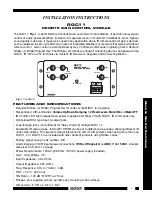
App. D - 1
Appendix D: The Psychrometric Chart
Psychrometrics defines the relationship between air temperature and moisture
content and their effect on relative humidity and dew point.
The psychrometric chart graphically represents the relationship of air
temperature and moisture content.
Developing an understanding of
psychrometrics and how to read the psychrometric chart will help you,
•
understand how to recognize and interpret the influence of ambient
conditions on chamber operation and achievable humidity range.
•
be aware of the performance capabilities of your chamber.
The psychrometic chart identifies five values.
1.
dry bulb temperature
–
the air temperature read by a shielded sensor
or simply, the air’s temperature.
2.
wet bulb temperature
–
a reading based on evaporative cooling effect.
To read the wet bulb temperature, cover a sensor using a wick that has
been thoroughly wetted and placed in a moving air stream.
The cooling
effect of the evaporating water causes a lower temperature compared to
the dry bulb air temperature.
3.
dew point temperature
–
the temperature at which condensation first
begins, as a mixture of air and water vapor is cooled. Above this
temperature, the moisture stays in vapor form in the air.
4.
moisture content
–
the amount of water vapour in the air by weight.
This is also referred to as the humidity ratio.
5.
relative humidity (percent saturation)
–
the percentage saturation of
the air at a given dry bulb temperature.
Relative humidity is a relative
measure, because the moisture-holding capacity of air increases as air
is warmed. In practice, relative humidity indicates the moisture level of
the air compared to the airs moisture-holding capacity at the same
temperature.







































